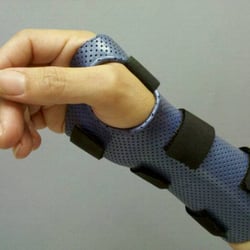|
BOOK NOW |
ASK ABOUT YOUR PAIN |
Home > Blog > Hand Therapy & Customized Splinting > Conditions > Finger, Hand, Wrist, Forearm & Elbow Conditions > Triangular Fibrocartilage Complex Tear Hand Therapy
Triangular Fibrocartilage Complex Tear Hand Therapy

Triangular fibrocartilage complex (TFCC) tear is a painful injury to the ligaments in the middle and outer side of the wrist.
You must understand that our TFCC ligaments keep our wrist joint stable so that means that if they are sprained or torn, that will cause our wrist to be
- unstable
- painful
Triangular fibrocartilage complex (TFCC) tears can happen from
- sudden trauma, such as falling on the wrist
- or develop over time from repetitive trauma or natural aging
The most common types of tears, “traumatic” TFCC tears, often occur in athletes participating in racquet sports and gymnastics, and in manual laborers, such as those who use power drills.
TFCC tears from aging, called “degenerative” tears, which can develop from wear and tear over time, most commonly are found in people over the age of 50.
Our senior hand therapists help people with TFCC injuries and tears to
- reduce pain
- reduce swelling
- reduce stiffness
- reduce any associated weakness in the wrist or upper extremity
- and return to improved or normal use of the hand and wrist
What is a Triangular Fibrocartilage Complex Tear?
TFCC is a group (or “complex”) of ligaments on the small-finger side of the wrist.
These ligaments keep the wrist bones stable, and attach the 2 forearm bones (the radius and the ulna) together near the wrist. TFCC tears typically happen to the dominant hand (as it is often a "use" injury).
There are 2 types of triangular fibrocartilage complex (TFCC) tear:
- Type I: The most common type of TFCC tear, from traumatic injury, usually occurs as the result of a fall onto the outstretched hand, or from a sudden pull (“traction”) on the wrist.
- Type II: This type of tear results from a degenerative injury that develops over time, usually occurring with age. Although degenerative TFCC tears have been diagnosed in people as young as in their 30s, they are most common in those aged 50 years and older. There is an increased risk of degenerative TFCC tears if a person has had a previous wrist trauma, or if one of the forearm bones (the ulna) is longer than the other (radius) from birth.

How Does Triangular fibrocartilage complex (TFCC) tear Feel?
With a TFCC tear, you may experience:
- Pain when leaning on the hand
- Swelling in the wrist
- Stiffness in the wrist
- Weak grip strength
- Clicking, catching, or creaking in the wrist
- Pain when turning a door handle or pushing up from sitting in a chair
- Pain when lifting heavy objects
How Is It Diagnosed?
If you see our senior hand therapist first, we will conduct a thorough evaluation that includes taking your health history.
We will also ask you detailed questions about your injury, such as:
- How and when did you notice the pain?
- How and when did you notice the swelling?
- Have you been performing any repetitive activity?
- Did you fall on your hand?
We also will perform special tests to help determine the likelihood that you have a TFCC tear.
We will gently press on parts of your wrist and arm to look for signs of tenderness or abnormal movement, observe how you can move your wrist and arm, and test your strength and flexibility.
To provide a definitive diagnosis, we may collaborate with an orthopedic physician or other health care provider, who may order further tests, such as an X-ray or MRI, to confirm the diagnosis and to rule out other damage to the wrist, like a wrist fracture, wrist sprain or infection.
how our senior hand therapists can help you

We will work with you to design a specific treatment program that will speed your recovery, including exercises and treatments that you can do at home.
Hand therapy will help you return to your normal lifestyle and activities.
Patients often ask us how many sessions or how much time will it take to fully recover from such a wrist injury, and the time it takes to heal the condition varies from person to person, but successful results can be achieved more quickly when a physical therapist implements an individualized swelling-management, stretching, motion, and strengthening program.
During the first 24 to 48 hours following your diagnosis, our senior hand therapist may advise you to:
- Apply light compression by wrapping the wrist a specific way, using a compressive wrap
- Rest the area by avoiding any activity that causes pain in the wrist
- Apply cold therapy to the area for 15 to 20 minutes every 2 hours
- Begin using a customized wrist splint or brace to protect the TFCC
- Consult with a physician for further services, such as medication or diagnostic tests
We will work with you to:
Reduce pain and swelling
If repetitive activities have caused the TFCC tear, we will help you understand how to avoid or modify the activities, to allow healing to begin. We may use different types of treatments and technologies to control and reduce your pain and swelling, including
- cold therapy
- heat therapy
- ultrasound therapy
- radio-frequency Indiba physiotherapy
- electrical stimulation
- compressive wraps
- taping
- bracing
- splinting
- exercises
- hands-on manual therapy such as specialized massage.
Improve motion
We will choose specific activities and treatments to help restore normal movement in the wrist, hand, and arm. These might begin with "passive" motions that the therapist performs for you to gently move your wrist, and progress to active exercises and stretches that you do yourself.
If a splint or brace for your wrist is recommended, we will teach you how and when to exercise the rest of your arm and hand, to prevent any problems from lack of use.
Improve flexibility.
We will determine if any arm muscles or structures are tight, start helping you to stretch them, and teach you how to stretch them.
Improve strength
If we find any weak or injured arm, hand, or wrist muscles, we will choose and teach you the correct exercises and equipment to steadily restore your strength and agility.
These may include using
- cuff weights
- stretch bands
- and weight-lifting equipment

Improve endurance
Restoring your arm’s muscular endurance is important after an injury.
We will develop a program of activities to help you regain the endurance you had before the injury, so you can return to doing the things you like to do.
Learn a home program
We will teach you strengthening and stretching exercises to perform at home. These exercises will be specific for your needs; if you do them as prescribed by our senior hand therapists, you can speed your recovery.
If a brace or splint is recommended for you to use on your wrist, we will explain how often you should remove it, and any exercises to do when it is removed.
Return to activities
We will discuss your activity goals with you and use them to set your work, sport, and home-life recovery goals. If you are an athlete, we may coordinate care with your coach and/or athletic trainer.
Your hand therapy treatment program will help you reach your goals in the safest, fastest, and most effective way possible. We will teach you exercises, work retraining activities, and sport-specific techniques and drills to help you achieve your goals.
Speed recovery time
We are trained and experienced in choosing the best treatments and exercises to help you safely heal, return to your normal lifestyle, and reach your goals faster than you are likely to do on your own.
If Surgery Is Necessary
Surgical repair of the TFCC could be recommended.
After surgery, you will follow a recovery program over several weeks or months, guided by your surgeon and our senior hand therapist.
We will help you
- minimize pain
- decrease swelling
- decrease stiffness
- regain motion
- regain strength
- and return to normal activities in the safest and speediest manner possible
Triangular fibrocartilage complex (TFCC) tear hand therapy may be able to help you avoid the need for opioid pain medication as well.